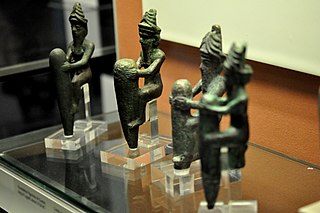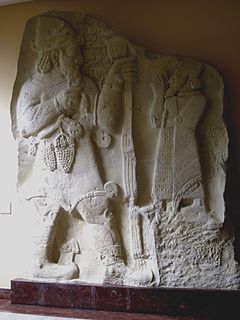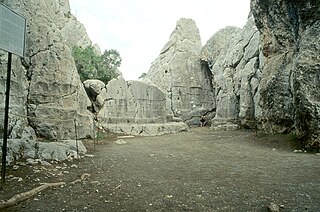
The Hurrians were a people of the Bronze Age Near East. They spoke a Hurro-Urartian language called Hurrian and lived in Anatolia, Syria and Northern Mesopotamia. The largest and most influential Hurrian nation was the kingdom of Mitanni, the Mitanni perhaps being Indo-Iranian speakers who formed a ruling class over the Hurrians. The population of the Indo-European-speaking Hittite Empire in Anatolia included a large population of Hurrians, and there is significant Hurrian influence in Hittite mythology. By the Early Iron Age, the Hurrians had been assimilated with other peoples. Their remnants were subdued by a related people that formed the state of Urartu. The present-day Armenians are an amalgam of the Indo-European groups with the Hurrians and Urartians.

Mitanni, also called Hanigalbat or Hani-Rabbat in Assyrian or Naharin in Egyptian texts, was a Hurrian-speaking state in northern Syria and southeast Anatolia.

The Anunnaki are a group of deities who appear in the mythological traditions of the ancient Sumerians, Akkadians, Assyrians, and Babylonians. Descriptions of how many Anunnaki there were and what role they fulfilled are inconsistent and often contradictory. In the earliest Sumerian writings about them, which come from the Post-Akkadian period, the Anunnaki are the most powerful deities in the pantheon, descendants of An and Ki, the god of the heavens and the goddess of earth, and their primary function is to decree the fate of Sumerians.

The Hattians were an ancient people who inhabited the land of Hatti in central Anatolia. The group was documented at least as early as the empire of Sargon of Akkad, until it was gradually absorbed c. 2000–1700 BC by the Indo-European Hittites, who were subsequently associated with the "land of Hatti".

Teshub was the Hurrian god of sky, thunder, and storms. Taru was the name of a similar Hattic Storm God, whose mythology and worship as a primary deity continued and evolved through descendant Luwian and Hittite cultures. In these two, Taru was known as Tarhun / Tarhunt- / Tarhuwant- / Tarhunta, names derived from the Anatolian root *tarh "to defeat, conquer". Taru/Tarhun/Tarhunt was ultimately assimilated into and identified with the Hurrian Teshub around the time of the religious reforms of Muwatalli II, ruler of the Hittite New Kingdom in the early 13th century BCE. These reforms can generally be categorized as an official incorporation of Hurrian deities into the Hittite pantheon, with a smaller number of important Hurrian gods being explicitly identified with preexisting major Hittite deities. Teshub reappears in the post-Hurrian cultural successor kingdom of Urartu as Tesheba, one of their chief gods; in Urartian art he is depicted standing on a bull.
Kumarbi is the chief god of the Hurrians. He is the son of Anu, and father of the storm-god Teshub. He was identified by the Hurrians with Sumerian Enlil, by the Greeks as Kronos and by the Ugaritians with El.
The Hutena were the three goddesses of fate of the Hurrian mythology. In Hittite mythology they were called the Gul Ses, Gul-Šeš, Gulšeš, or Gul-aššeš.
In Hurrian mythology, Upelluri was the "dreaming god". Kumarbi placed the stone giant Ullikummi on Upelluri's shoulders to grow up. In his slumber, Upelluri was unaware of his burden. He has been compared to Atlas from Greek mythology. The Hittite counterpart was Ubelluris, a mountain god who carried the western edge of the sky on his shoulders.
Zababa is a war god who was the tutelary deity of the city of Kish in ancient Mesopotamia. He is connected with the god Ninurta, and the symbol of Zababa − the eagle-headed staff − was often depicted next to Ninurta's symbol. Inanna and Baba are variously described as his wife. His sanctuary was the E-meteursag.

Yazılıkaya was a sanctuary of Hattusa, the capital city of the Hittite Empire, today in the Çorum Province, Turkey. Rock reliefs are a prominent aspect of Hittite art, and these are generally regarded as the most important group.
Ishara is an ancient deity of unknown origin from northern modern Syria. She first appeared in Ebla and was incorporated into the Hurrian pantheon, from which she found her way to the Hittite pantheon.

Hittite mythology and Hittite religion were the religious beliefs and practices of the Hittites, who created an empire centered in what is now Turkey from c. 1600 BC to 1180 BC.
Kizzuwatna, is the name of an ancient Anatolian kingdom in the 2nd millennium BC. It was situated in the highlands of southeastern Anatolia, near the Gulf of İskenderun, in modern-day Turkey. It encircled the Taurus Mountains and the Ceyhan River. The centre of the kingdom was the city of Kummanni, in the highlands. In a later era, the same region was known as Cilicia.

Sapinuwa was a Bronze Age Hittite city at the location of modern Ortaköy in the province Çorum in Turkey. It was one of the major Hittite religious and administrative centres, a military base and an occasional residence of several Hittite kings. The palace at Sapinuwa is discussed in several texts from Hattusa.
In Hurrian mythology, Ullikummi is a giant stone monster, son of Kumarbi and the sea god's daughter, Sertapsuruhi, or a female cliff. The language of the literary myth in its existing redaction is Hittite, in cuneiform texts recovered at Bogaskoy, where some Hurrian fragments of the "Song of Ullikummi" have been found. See Guterbock (1951).

Šauška or Shaushka was a Hurrian goddess who was also adopted into the Hittite pantheon. She is known in detail because she became the patron goddess of the Hittite king Hattusili III following his marriage to Puduhepa, the daughter of the goddess' high priest. Her cultic center was Lawazantiya in Kizzuwatna.
Hans Gustav Güterbock was a German-American Hittitologist. Born and trained in Germany, his career was ended with the rise of the Nazis because of his Jewish heritage, and he was forced to resettle in Turkey. After the Second World War, he immigrated to the United States and spent the rest of his career at the University of Chicago.
Šuwaliyat is a Hittite god. His Hurrian correspondence is Tasmisu.

The Hurrian religion was the polytheistic religion of the Hurrians, a Bronze Age people of the Near East. These people settled over a wide area, so there were differences between them, especially between the eastern Hurrians around Nuzi and Arrapha and the western Hurrians in Syria and Anatolia. From the 14th century BC, the Hurrian religion had a powerful influence on the Hittite religion and the Hurrian pantheon is depicted in the 13th century rock reliefs at the important Hittite sanctuary at Yazılıkaya.

Arma was an Anatolian Moon god, worshipped by the Hittites and Luwians in the Bronze Age and early Iron Age.










